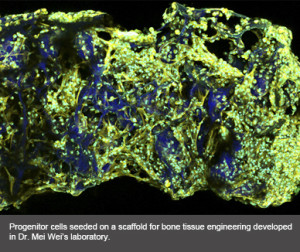 Dr. Pu-Xian Gao (Materials Science & Engineering and the Institute of Materials Science) was awarded a $1.45 million grant from the National Science Foundation (NSF) for his project SNM: Scalable and Sustainable Hydrothermal Manufacturing of Nano-array based Low Temperature Diesel Oxidation Catalysts. The project is funded through an NSF program focused on collaborative research and education in the area of scalable nanomanufacturing aimed at overcoming impediments that prevent the low-cost production of useful nanomaterials on a larger, industrially-relevant scale. Dr. Gao’s collaborators include Drs. Tianfeng Lu and Zhuyin Ren (Mechanical Engineering) and Dr. Steven Suib of Chemistry. Read the full story here.
Dr. Pu-Xian Gao (Materials Science & Engineering and the Institute of Materials Science) was awarded a $1.45 million grant from the National Science Foundation (NSF) for his project SNM: Scalable and Sustainable Hydrothermal Manufacturing of Nano-array based Low Temperature Diesel Oxidation Catalysts. The project is funded through an NSF program focused on collaborative research and education in the area of scalable nanomanufacturing aimed at overcoming impediments that prevent the low-cost production of useful nanomaterials on a larger, industrially-relevant scale. Dr. Gao’s collaborators include Drs. Tianfeng Lu and Zhuyin Ren (Mechanical Engineering) and Dr. Steven Suib of Chemistry. Read the full story here.
Professor Emeritus Dr. Lee Langston (Mechanical Engineering) authored an article appearing in the December 2013 issue of Mechanical Engineering magazine, entitled “Powering Out of Trouble,” which discussed Pratt & Whitney’s challenges in developing the J58 turbojet engine that powered Lockheed’s SR-71 Blackbird supersonic reconnaissance aircraft. Read the article here.
Dr. Mark Tehranipoor (Electrical & Computer Engineering) and two colleagues have written a new book, Integrated Circuit Authentication – Hardware Trojans and Counterfeit Detection (ISBN 978-3-319-00816-5), published by Springer. His co-authors, both of whom earned their PhDs with Dr. Tehranipoor, are Hassan Salmani (Ph.D. Electrical & Computer Engineering ’11) and Xuehui Zhang (Ph.D. Electrical & Computer Engineering ’13). Dr. Tehranipoor is Director of the Center for Hardware Assurance, Security and Engineering and a leading expert on hardware Trojans.
###
Materials Science & Engineering Ph.D. student Max Villa (B.S. ’07; M.S. ‘09) is a co-author, with Dr. Liping Wang, M.D., graduate student Jianping Huan g, Dr. David W. Rowe, M.D. and MSE Professor and Associate Dean for Research & Graduate Education Dr. Mei Wei, of a scholarly journal paper appearing in the biomedical journal Tissue Engineering. The article, entitled “Visualizing Osteogenesis in Vivo Within a Cell–Scaffold Construct for Bone Tissue Engineering Using Two-Photon Microscopy,” was featured in the Part C:
g, Dr. David W. Rowe, M.D. and MSE Professor and Associate Dean for Research & Graduate Education Dr. Mei Wei, of a scholarly journal paper appearing in the biomedical journal Tissue Engineering. The article, entitled “Visualizing Osteogenesis in Vivo Within a Cell–Scaffold Construct for Bone Tissue Engineering Using Two-Photon Microscopy,” was featured in the Part C:  Methods section of the November 2013 issue of Tissue Engineering. An image developed by the team, showing an optical section of a mouse skull in which osteoprogenitor cells are revealed (acquired via two-photon microscopy), was featured on the cover. Read the full story here.
Methods section of the November 2013 issue of Tissue Engineering. An image developed by the team, showing an optical section of a mouse skull in which osteoprogenitor cells are revealed (acquired via two-photon microscopy), was featured on the cover. Read the full story here.




